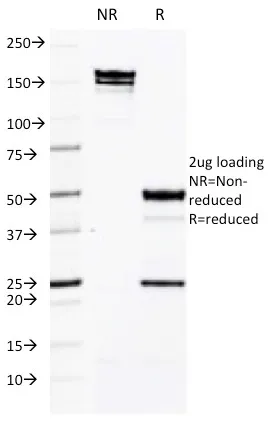Anti-CD50 / ICAM3(CG106)
CAT:
37-BNUB2216-500
Size:
500 µL
Price:
Ask
- Availability: 24/48H Stock Items & 2 to 6 Weeks non Stock Items.
- Dry Ice Shipment: No




Anti-CD50 / ICAM3(CG106)
- Description: Recognizes the D1 domain of an N-glycosylated glycoprotein of 120 kDa with intra-chain disulfide bonds, identified as CD50 or ICAM-3 (Leucocyte Workshop VI). CD50 is the major ligand for LFA-1 (CD11a/CD18) and may have signaling role to increase adhesion. It is expressed on thymocytes and T lymphocytes and is resistant to treatment with phosphatidylinositol (PI) phospholipase C. This MAb is excellent for staining of formalin/paraffin tissues._x000D_ _x000D_ Primary antibodies are available purified, or with a selection of fluorescent CF® Dyes and other labels. CF® Dyes offer exceptional brightness and photostability. Note: Conjugates of blue fluorescent dyes like CF®405S and CF®405M are not recommended for detecting low abundance targets, because blue dyes have lower fluorescence and can give higher non-specific background than other dye colors._x000D_ _x000D_
- Synonyms: CD50; CDW 50; CDw50; ICAM 3; ICAM-3; ICAM-R; ICAM3; ICAM3_HUMAN; ICAMR; Intercellular adhesion molecule 3
- CAS Number: 9007-83-4
- UNSPSC: 41116161
- UNSPSC Description: Primary and secondary antibodies for multiple methodology immunostaining detection application
- Gene Name: ICAM3
- Gene ID: 3385
- NCBI Gene ID: 654563
- UniProt: P32942
- Cellular Locus: Plasma membrane
- Host: Mouse
- Species Reactivity: Human
- Immunogen: Stimulated human leukocytes
- Target Antigen: CD50 | ICAM3
- Clonality: Monoclonal
- Isotype: IgG2a κ
- Clone: CG106
- Conjugation: Purified, with BSA
- Source: Animal
- Applications: Flow, surface (published) | Functional studies (published) | ELISA (published)
- Validated Applications: FC, ELISA
- Field of Research: Immunology
- Positive Control: HL-60 or THP-1 cells. Lymph node and tonsil
- Concentration: 0.2 mg/mL
- Buffer: PBS, 0.05% BSA, 0.05% azide
- Molecular Weight: 110-160 kDa
- References & Citations: Note: References for this clone sold by other suppliers may be listed for expected applications. J Biol Chem (1995) 270(2): 877-884. (ELISA) J Invest Dermatol (1995) 105, 215-219.(functional studies) J Cell Biol (1995) 129(4):1143-1153. (Flow, surface) J Immunol 1998; 161:1363-1370. (ELISA; epitope mapping) Am J Pathol (2001) 159(1): 285-295. (Flow, surface)
- Shipping Conditions: Room temperature
- Storage Conditions: 4°C; Stable at room temperature or 37°C (98°F) for 7 days.
- Shelf Life: 2 years
